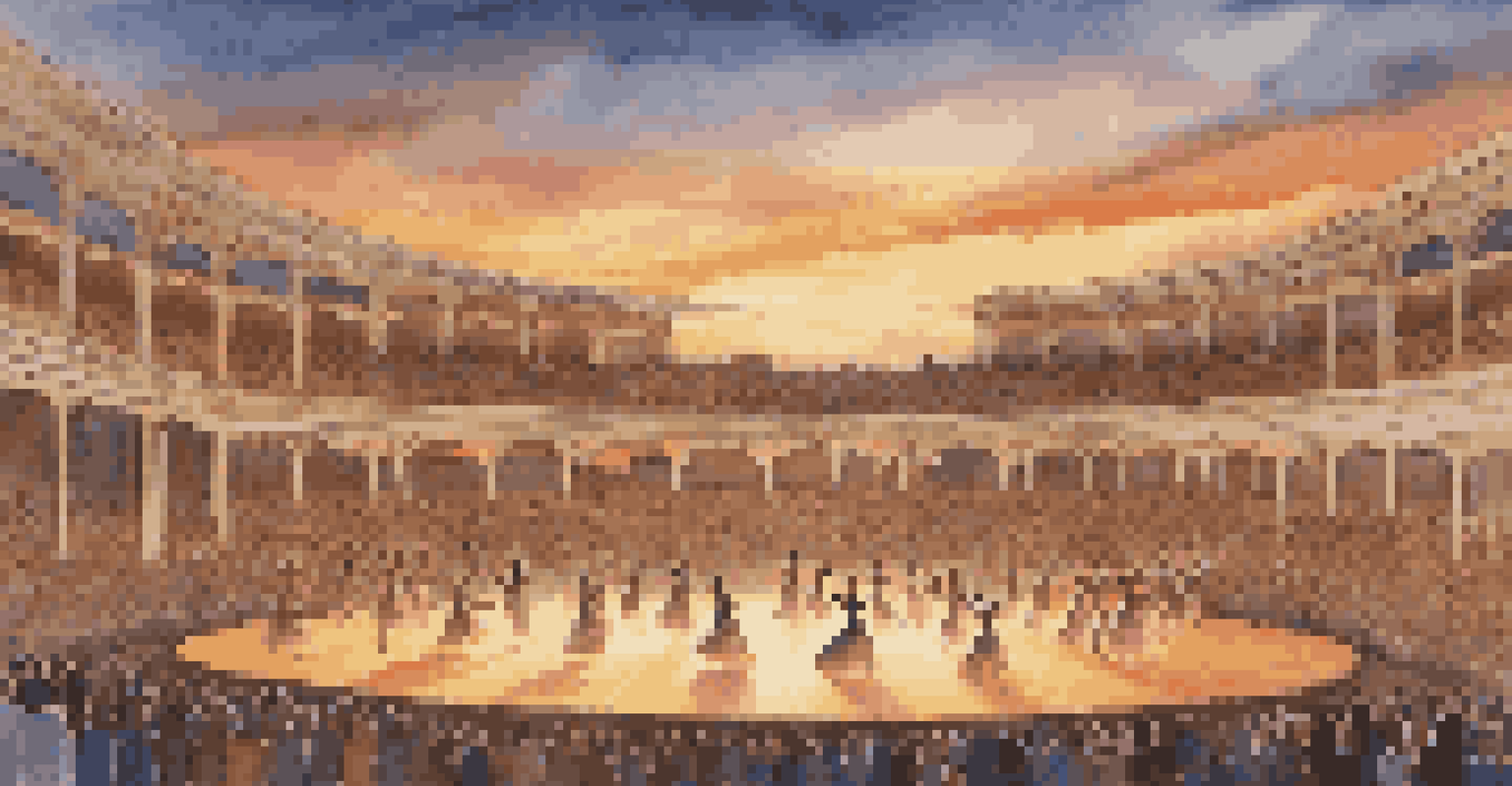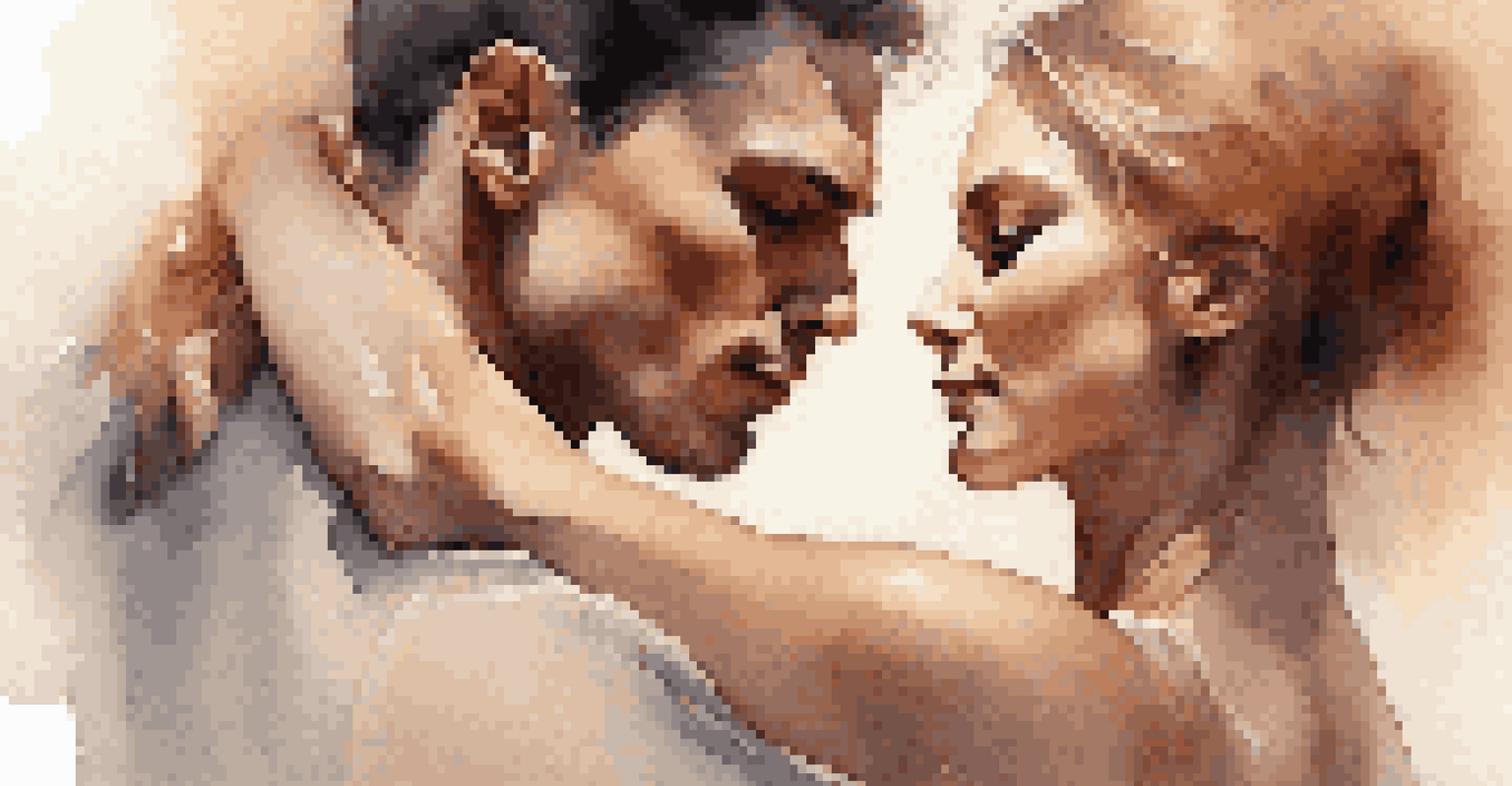Behind the Scenes: The Making of Iconic Dance Scenes

The Vision: Conceptualizing Dance Scenes
Every iconic dance scene begins with a vision. Directors and choreographers often brainstorm together to create a concept that resonates with the story. For example, the iconic 'Thriller' music video was revolutionary because it blended dance with horror elements, creating a narrative that captivated audiences.
Dance is the hidden language of the soul.
During this phase, they consider the emotions they want to evoke and how dance can enhance the storytelling. This collaboration is crucial, as it lays the groundwork for the choreography and overall aesthetic. Think of it as crafting a recipe; each ingredient must complement the others for the best results.
Ultimately, this vision serves as a roadmap for the entire production, guiding decisions from casting to set design. The clearer the vision, the more compelling the dance scenes will be, setting the stage for what’s to come.
Choreography: The Heart of Dance Scenes
Once the vision is established, it's time for choreography to take center stage. Choreographers draw from various dance styles to create movements that feel organic to the characters and the narrative. This is where creativity flourishes, as they experiment with different formations and sequences.

For instance, the choreography in 'La La Land' was designed to feel like a natural extension of the characters' emotions. The iconic 'A Lovely Night' duet showcases how dance can express joy and connection, enhancing the film's romantic theme.
Vision Shapes Dance Scene Success
A clear vision guides the choreography and overall aesthetic of dance scenes, ensuring they resonate with the story.
Choreography is not just about the steps; it's about telling a story through movement. The right choreography can elevate a dance scene from good to unforgettable, allowing audiences to connect deeply with the film.
Casting Dancers: Finding the Right Talent
Casting the right dancers is crucial for bringing a dance scene to life. Dancers must not only possess technical skills but also the ability to convey emotions through their movements. Auditions become a vital part of this process, as choreographers look for performers who embody the vision.
Every dance is a story, and every story has a dance to tell.
For example, in the 'Dirty Dancing' finale, Jennifer Grey and Patrick Swayze were cast not just for their dancing abilities, but for their on-screen chemistry. Their connection made the iconic lift scene even more memorable, showcasing how casting can influence the overall impact of a dance.
Moreover, involving a diverse range of talent can add richness to the performance, as different backgrounds bring unique perspectives to the choreography. This diversity helps create more dynamic and relatable dance scenes.
Rehearsals: Perfecting the Dance Routine
Rehearsals play a pivotal role in the making of dance scenes. During this time, dancers practice their routines relentlessly, refining their movements and timing. This commitment to precision ensures that every step looks flawless when the cameras start rolling.
A famous example is the rehearsal process for the 'West Side Story' dance scenes, where dancers spent weeks perfecting their craft. The rigorous practice not only builds technical skill but also fosters camaraderie among the cast, creating a sense of unity that translates on screen.
Choreography Tells the Story
Effective choreography transforms movements into powerful storytelling tools that enhance emotional connections with the audience.
Rehearsals are often filled with laughter and challenges, helping dancers bond over shared experiences. This camaraderie is essential, as it enhances their performance, making it feel more authentic and connected to the story.
Filming Techniques: Capturing Dance Magic
When it comes to filming dance scenes, techniques can make all the difference. Directors and cinematographers use various angles, lighting, and camera movements to capture the essence of each performance. For instance, a sweeping crane shot can elevate a dance scene, making it feel grand and epic.
In 'Chicago,' the use of dynamic camera angles adds a layer of excitement, immersing viewers in the action. The choreography and camera work come together to create a visual feast that leaves lasting impressions.
Additionally, careful consideration of editing plays a critical role in how dance scenes are perceived. The rhythm of the cuts can enhance the flow of the dance, creating an engaging experience that resonates with audiences.
Music: Setting the Tone for Dance Scenes
Music is the lifeblood of dance scenes, setting the emotional tone and guiding the choreography. The right soundtrack can elevate a performance, turning it into an unforgettable moment. For example, the use of 'Stayin’ Alive' in 'Saturday Night Fever' perfectly encapsulated the disco era and became synonymous with the film.
During the production process, music choices are often made in collaboration with choreographers to ensure a seamless integration. The rhythm, tempo, and lyrics all play a vital role in shaping the dancers' movements and expressions.
Post-Production Polishes Performances
Meticulous editing and sound design in post-production elevate dance scenes, ensuring they captivate and engage viewers.
Ultimately, music not only enhances the dance but also helps connect with the audience on a deeper emotional level. It's this synergy between dance and music that creates those iconic scenes we all remember.
Post-Production: Final Touches on Dance Scenes
After filming, the magic continues in post-production, where dance scenes are polished to perfection. Editors work meticulously, ensuring that every movement syncs seamlessly with the music and narrative. This phase can involve cutting, rearranging, and even adding visual effects to enhance the overall impact.
In films like 'Step Up,' post-production plays a significant role in creating the high-energy vibe that defines the franchise. Editors might use techniques like slow motion or rapid cuts to intensify the dance sequences, making them more thrilling.

Moreover, sound editing is crucial, as it amplifies the music and adds layers to the performance. This careful attention to detail during post-production ensures that the final product resonates with audiences, leaving them in awe of the artistry behind the scenes.